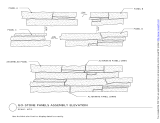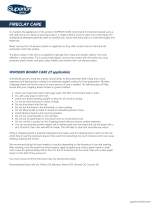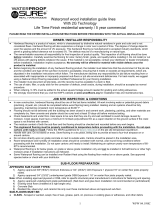
INSTALLATION, CARE AND MAINTENANCE
INTERBUILD PANEL PRODUCTS
STORAGE OF WOOD PANELS
WHEN STORING: The Wood panels should be stored flat. Wood panels must be fully supported at all times and kept away from any direct heat source, i.e.
radiators. PLEASE NOTE: Never store vertically or on a direct heat source or the Wood panel will start to bow. If the Wood panel has bowed, turn the
Wood panel upside down for a day or so horizontally and it will straighten out.
ACCLIMITIZATION: Immediately prior to installation the panels must be laid flat and be allowed to acclimatize in the room where they will be fitted, for a
minimum period of 48 hours before fitting. Protect the panels from extreme changes in temperature and humidity. This acclimatization period is ideal for
applying natural Wood Oil to end grains and cuts, where future access will be a problem.
ROOM PREPARATION: Please ensure that any plastering or plumbing required is complete and has been allowed to dry prior to installing the wood panels.
BEFORE INSTALLATION
All tops are factory stained but not sealed. It is the responsibility of the installer to follow the company’s finishing instructions regarding the application of
a natural wood oil treatment before installation. The tops are not properly sealed until the wood oil sealer is applied to the product.
Before installation apply the first coat of Wood Oil. The Oil should be applied to both sides of the Wood panel and also all edges and tap holes that have
been cut. Let the Wood panel soak up as much Oil as possible. Cut ends, holes and end grains require three (3) natural Oil applications prior to fitting.
Note: Once the Wood panel has been fitted cut ends and holes will be inaccessible and must be well oiled prior to installation. Wood is a natural product and
will expand and contract. Wood can be affected by heat and humidity.
INSTALLING A WORKTOP OR PANEL
EXPANSION GAPS AND SILICONE SEALANT
Solid wood is a living material that will expand and shrink with temperature and humidity variances. Always leave a 5mm expansion gap to all other dead
surfaces such as Stone, Steel, Walls and Pipes. Use a quality expandable silicone sealant when fitting and filling expansion gaps. It is recommended to use
only the best quality silicone sealant (white or clear) where required.
WOOD PANEL INSTALLATION – FIXING TO CABINETS
Angle brackets should be used to secure the Wood panel to the carcass. The elongated hole of the bracket needs to be screwed to the underside of the Wood
panel. Always use washers with the screws to all for humidity expansion changes
CUTTING THE WOOD PANEL
When using a fine-toothed panel saw, cut panel with Wood panel face upwards. When using a jigsaw, saw cut panel with face downwards. Cuts require at least three
oil applications before fitting.
FITTING THE WOOD PANEL
Your Wood panel naturally wants to warp and bend when exposed to changing humidity and temperature. In order to avoid this, solid tight fitting to the
surrounding surfaces is required. Secure the Wood panel with angle brackets and screws every 20 cm on all sides. Use the angle brackets to the wall side if
there is no cabinet to fix the wood panel to. Pre-drill holes in the Wood panel where screws are required in order to ease tension. Screws should penetrate the
Wood panel by a minimum of 15mm.
Over

INSTALLING A WORKTOP OR PANEL (Continued)
FIXING TO BRICKWORK.
When fixing a Wood panel to a brick pier you must ensure that the brickwork is completely dry. As a precaution glue a damp-proof barrier foil to the side or
underside of the Wood panel that has already been well oiled and dried. Fix with adhesive. This will help form a moisture barrier between the Wood panel and
the brickwork. We also advise that alternate fixing points be made along the length of the Wood panel to prevent it from bowing.
CORNER JOINTS.
When joining two Wood panels together it is recommended that both biscuit joints and standard Wood panels bolts are used in order to avoid temperature
warping at a later stage. Treat the joining edge and the underneath of the Wood panel lavishly with oil before joining and fitting the Wood panels.
INSERTING HOBS, TILES OR STONE MATERIALS.
Always leave a 5mm expansion gap. Use silicone sealant when fitting and filling expansion gaps. The wood may crack if you do not allow for expansion gaps.
Range cookers, such as AG A's, require a minimum expansion gap of 40 mm due to the constant heat source from these cookers.
KITCHEN APPLIANCES.
If a dishwasher or washing machine is to be installed under the Wood panel it is recommended to glue an insulation reflective foil and moisture barrier to the
underside of the Wood panel to protect it from intense heat. A minimum 25mm gap should be allowed for ventilation above the appliance. Leave a 15mm gap
between the end of tops and appliances, cut-outs for appliances and sinks.
FITTING AN INSET SINK
This is the same procedure as with fitting a laminate Wood panel. Expansion gaps must be left and sealed with silicone sealant. Take great care when installing
sinks into timber Wood panels, due to the possibility of water penetration into the joints. When positioning and making a cut-out for a hob always follow the
manufacturer's instructions for sizes, safety clearances, and sealing with silicone sealant.
UNDERMOUNTING SINKS.
The skills required for undermounting Belfast type sinks in a solid hardwood Wood panel is best left to expert fitters.
CARE & MAINTENANCE
WOOD OIL PRIOR TO INSTALLATION – APPLY LAVISHLY.
Prior to installation you must generously Oil all the surfaces of the Wood panel, paying particular attention to the underside, cut edges and back edges.
Once the Wood panel has been fitted these areas and cut edges may be inaccessible. We recommend that all cut edges and end grains will need a further
2 coats (for a total of 3 coats) to ensure that the Oil has penetrated deep into the wood. When oiling remember to wipe away the excess oil after 15 minutes
and then allow to dry for 6 - 8 hours prior to further applications. Please give special attention to the oiling of the end grains and cut ends to seal them properly.
Apply the oil with a sponge or soft cloth. Never use steel wool to sand the surface as this may cause the Wood panel to become discolored when damp.
ONGOING MAINTENANCE OF THE WOOD PANEL
In the first few weeks of use some care must be taken to prevent Wood panels becoming stained before they have built up sufficient protection. Avoid letting
water build up on the worksurface, wipe off using a cloth. The Wood panels require to be oiled again within the first week of installation. Apply a thin coat of the
same type of oil, leave for 15 minutes and then wipe off the excess. This is best done at night to allow maximum time for the Wood panel to dry off, overnight.
After the first week, oiling once a week will suffice with the interval between treatments gradually increasing until eventually you are just wiping Wood panels
with an oily cloth once a month or so to restore the sheen that has built up. As a useful hint, the Wood panel will need oiling when water on the surface
smudges rather than forms a well-defined water droplet, or when the Wood panel feels dry.
REPAIR AND LONG TERM MAINTEANCE.
After years of hard use your Wood panel may sustain some stains, scrapes and grazes. To refurbish your Wood panel, lightly sand it down with a sanding machine
or with fine sandpaper. For smaller areas of damage, sand locally and oil again.
WARRANTY
The Company warrants that the Products will be free from material defects in materials and workmanship and will operate substantially in conformance
with the Company's documentation for a period of 1 year. This warranty period begins the date on which the Products are shipped to its customers. This
warranty does not apply to Products that have been subject to misuse, including neglect, accident, or modification, or that have been altered during
assembly and are not capable of being tested by the Company under its normal test conditions. The Company's obligation for Products failing to meet
this warranty is to refund the purchase price of the nonconforming Product, or to replace or repair the nonconforming Products.
Each Interbuild solid wood finger jointed Wood panel is manufactured from selected material and is subject to stringent quality control procedures. The
company cannot be held responsible for their further maintenance and installation, which is dependent upon the standard of work of individual
contractors and the end user. No warranty is granted on fitted tops, mitered joints, or where there are a lack of expansion or heat evaporating gaps. True
factory faults are delamination of glue joints, which should not occur. Other potential faults discovered at a later stage after assembling and installation,
such as cracked wood, bowing wood or deformed wood of any kind, that appear due to failure to follow installation and maintenance instructions
provided in this leaflet has not being followed are not covered by this warranty.
TIPS
• Hot pans should be placed on a pan stand or similar and not directly onto the worksurface.
• Always use a chopping board for food preparation, not the worksurface.
• Avoid letting water build up on the worksurface, wipe off using a cloth.
• The surface should be cleaned with a warm damp cloth with a little washing up liquid.
• Re-oil your Wood panel and workstation regularly.
PRECAUTION
Cloths and sponges used when treating your Wood panel with oil may become FLAMMABLE. Please store or dispose of them safely.
2019 Interbuild Distribution (US) LLC, a Division of Interbuild Holding, LTD, Hong Kong. L7: Installation, Care and Maintenance Instructions
-
 1
1
-
 2
2
Ask a question and I''ll find the answer in the document
Finding information in a document is now easier with AI
Other documents
-
 Native Custom Stone 855339004027 Operating instructions
Native Custom Stone 855339004027 Operating instructions
-
LAMONA SNK4961 Operating instructions
-
LAMONA SNK2124 Operating instructions
-
LAMONA SNK5836 Operating instructions
-
Direct vanity sink 63D7-EWC-LM Installation guide
-
IPT Sink Company IPTFC60PLN7636C User manual
-
 Superior Sinks SPFC36PLNP User manual
Superior Sinks SPFC36PLNP User manual
-
Mohawk HCC58-10 Installation guide
-
Shaw DH83300879 Installation guide
-
 Sure 13S5CWO7D119WG User manual
Sure 13S5CWO7D119WG User manual





